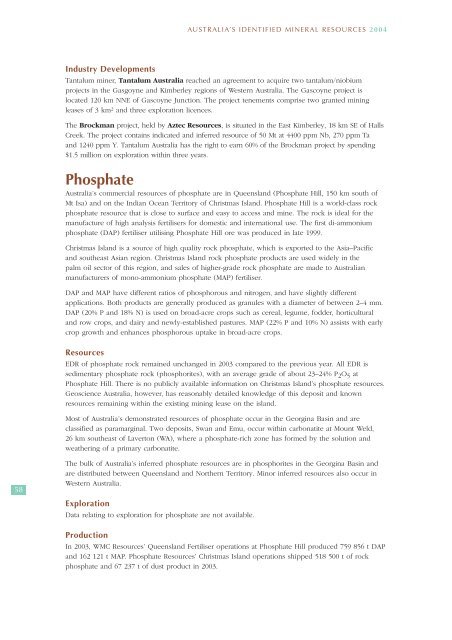australia's identified mineral resources 2004 - Geoscience Australia
australia's identified mineral resources 2004 - Geoscience Australia
australia's identified mineral resources 2004 - Geoscience Australia
Create successful ePaper yourself
Turn your PDF publications into a flip-book with our unique Google optimized e-Paper software.
AUSTRALIA’S IDENTIFIED MINERAL RESOURCES <strong>2004</strong><br />
Industry Developments<br />
Tantalum miner, Tantalum <strong>Australia</strong> reached an agreement to acquire two tantalum/niobium<br />
projects in the Gasgoyne and Kimberley regions of Western <strong>Australia</strong>. The Gascoyne project is<br />
located 120 km NNE of Gascoyne Junction. The project tenements comprise two granted mining<br />
leases of 3 km 2 and three exploration licences.<br />
The Brockman project, held by Aztec Resources, is situated in the East Kimberley, 18 km SE of Halls<br />
Creek. The project contains indicated and inferred resource of 50 Mt at 4400 ppm Nb, 270 ppm Ta<br />
and 1240 ppm Y. Tantalum <strong>Australia</strong> has the right to earn 60% of the Brockman project by spending<br />
$1.5 million on exploration within three years.<br />
Phosphate<br />
<strong>Australia</strong>’s commercial <strong>resources</strong> of phosphate are in Queensland (Phosphate Hill, 150 km south of<br />
Mt Isa) and on the Indian Ocean Territory of Christmas Island. Phosphate Hill is a world-class rock<br />
phosphate resource that is close to surface and easy to access and mine. The rock is ideal for the<br />
manufacture of high analysis fertilisers for domestic and international use. The first di-ammonium<br />
phosphate (DAP) fertiliser utilising Phosphate Hill ore was produced in late 1999.<br />
Christmas Island is a source of high quality rock phosphate, which is exported to the Asia–Pacific<br />
and southeast Asian region. Christmas Island rock phosphate products are used widely in the<br />
palm oil sector of this region, and sales of higher-grade rock phosphate are made to <strong>Australia</strong>n<br />
manufacturers of mono-ammonium phosphate (MAP) fertiliser.<br />
DAP and MAP have different ratios of phosphorous and nitrogen, and have slightly different<br />
applications. Both products are generally produced as granules with a diameter of between 2–4 mm.<br />
DAP (20% P and 18% N) is used on broad-acre crops such as cereal, legume, fodder, horticultural<br />
and row crops, and dairy and newly-established pastures. MAP (22% P and 10% N) assists with early<br />
crop growth and enhances phosphorous uptake in broad-acre crops.<br />
Resources<br />
EDR of phosphate rock remained unchanged in 2003 compared to the previous year. All EDR is<br />
sedimentary phosphate rock (phosphorites), with an average grade of about 23–24% P 2 O 5 at<br />
Phosphate Hill. There is no publicly available information on Christmas Island’s phosphate <strong>resources</strong>.<br />
<strong>Geoscience</strong> <strong>Australia</strong>, however, has reasonably detailed knowledge of this deposit and known<br />
<strong>resources</strong> remaining within the existing mining lease on the island.<br />
Most of <strong>Australia</strong>’s demonstrated <strong>resources</strong> of phosphate occur in the Georgina Basin and are<br />
classified as paramarginal. Two deposits, Swan and Emu, occur within carbonatite at Mount Weld,<br />
26 km southeast of Laverton (WA), where a phosphate-rich zone has formed by the solution and<br />
weathering of a primary carbonatite.<br />
58<br />
The bulk of <strong>Australia</strong>’s inferred phosphate <strong>resources</strong> are in phosphorites in the Georgina Basin and<br />
are distributed between Queensland and Northern Territory. Minor inferred <strong>resources</strong> also occur in<br />
Western <strong>Australia</strong>.<br />
Exploration<br />
Data relating to exploration for phosphate are not available.<br />
Production<br />
In 2003, WMC Resources’ Queensland Fertiliser operations at Phosphate Hill produced 759 856 t DAP<br />
and 162 121 t MAP. Phosphate Resources’ Christmas Island operations shipped 518 500 t of rock<br />
phosphate and 67 237 t of dust product in 2003.

















